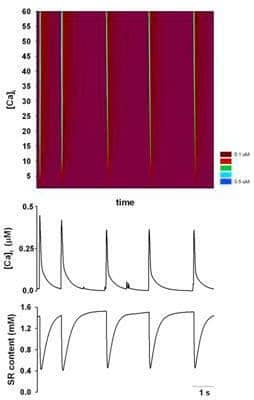Mechanical alternans in cardiac muscle is believed to be associated with intracellular Ca alternans. Mechanisms underlying intracellular Ca alternans are unclear. In previous experimental study we produced alternans of systolic Ca under voltage clamp by applying small depolarizing pulses. The aim of this study is to investigate by computer modeling how such alternans of systolic Ca is produced. A mathematical model of coupled cluster of 60 Ca release units is developed. Each release unit contains a stochastic unitary L-type Ca channel modeled by 12 states of Markovian chain model developed by Jafri et al, a subspace, a cytoplasm space and sarcoplasmic reticulum (SR) release channel and uptake sites (SERCA). Inter-units coupling is via Ca diffusion between neighbouring cytoplasm spaces and from subspaces to cytoplasm spaces. A series of voltage stimulus pulses, which steps from a -40 mV to -20 mV, was used to simulate low depolarization as we used in our previous experimental study. The model was paced by 1 Hz. During stimulation, at each Ca unit, localized Ca transient ([Ca]i) at cytoplasmic space and SR content were recorded and plotted in the time-space format. The 12-state Markovian chain model can reproduce the channel current of a single unitary L-type channel, and a minimal of upto 5000 channels are required to reproduce the properties of L-type Ca channel I-V relationship as seen at whole cell level. Corresponding to a series of small depolarization pulses, systolic Ca alternans were observed, during which a large Ca transient was followed by a small Ca transient. The simulated Ca alternans was consistent with our experimental observations, being generated by propagating waves of Ca release and sustained through an alternation of SR Ca content. This study provides novel and fundamental insights to understand how the low pulse affects the behavior of unitary L-type channel and the mechanisms underlying intracellular Ca alternans produced by low depolarization.
University of Manchester (2007) Proc Physiol Soc 8, PC33
Poster Communications: Mechanism of Ca intracellular alternans produced by low depolarization – A study by a stochastic Ca handling model
T. Tao1, S. C. O'Neill2, S. Kharche1, H. Zhang1
1. Biological Physics Group, School of Physics and Astronomy, The University of Manchester, Manchester, United Kingdom. 2. Unit of Cardiac Physiology, School of Medicine,, The University of Manchester, Manchester, United Kingdom.
View other abstracts by:
Where applicable, experiments conform with Society ethical requirements.

